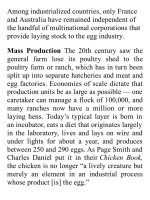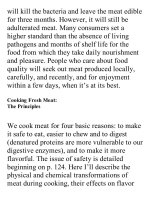On food and cooking the science and lore of the kitchen ( PDFDrive ) 85
Bạn đang xem bản rút gọn của tài liệu. Xem và tải ngay bản đầy đủ của tài liệu tại đây (111.88 KB, 2 trang )
brineandasealedcylindercontainingtheicecreammixandamixingblade,whoseshaft
protrudedfromthetopandcouldbecranked
continuously.Fiveyearslater,WilliamG.
YoungofBaltimoremodifiedJohnson’s
designtomakethemixcontainerrotateinthe
brineformoreefficientcooling.TheJohnsonYoungfreezerallowedlargequantitiesof
fine-texturedicecreamtobemadewitha
simple,steadymechanicalaction.
Thesecondfatefuladvancetowardmass
productioncameintheearly1850s,whena
BaltimoremilkdealerbythenameofJacob
Fusselldecidedtousehisseasonalsurplusof
creamtomakeicecream,wasabletocharge
halfthegoingpriceinspecialtyshops,and
enjoyedgreatsuccessasthefirstlarge-scale
manufacturer.Hisexamplecaughton,sothat
by1900anEnglishvisitorwasstruckbythe
“enormousquantities”oficecreameatenin
America.TodayAmericansstilleat
substantiallymoreicecreamthanEuropeans
do,nearly20quarts/litersperpersonevery
year.
TheIndustrializationofIceCream Once ice
cream became an industrial product, industry
redefinedit.Manufacturerscouldfreezetheir
icecreamfasterandcolderthanthehandmade
version, and so could produce very fine ice
crystals. Smoothness of texture became the
hallmark of industrial ice cream, and
manufacturers accentuated it by replacing
traditional ingredients with gelatin and
concentratedmilksolids.AfterWorldWarII,
theydosedicecreamwithgreateramountsof
stabilizers to preserve its smoothness in the
new and unpredictable home freezers. And
pricecompetitionledtotheincreasinguseof
additives, powdered milk from surplus
production, and artificial flavors and colors.
So an ice cream hierarchy developed.At the
top is traditional but relatively expensive ice
cream; at the bottom, a lower-quality but









